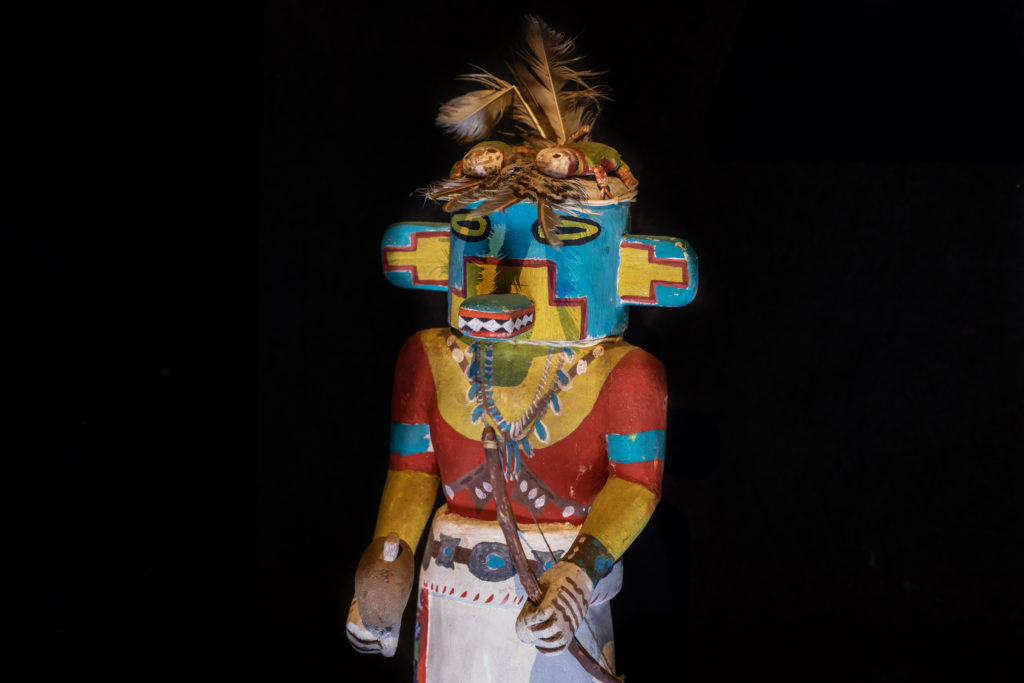Kachina dolls are familiar Native American museum objects. They appear in art galleries and anthropology exhibits alike, but they are often misrepresented, misidentified, and misunderstood. Even the term kachina leads to confusion; it is an Anglicized spelling of the Hopi word katsina (singular) or katsinam (plural). In the Hopi worldview, katsinam take on three different forms:
- They are ancestral beings in the spirit world who bless the land with moisture,
- They are the spirits that present themselves at the Hopi Mesas each year in ceremonies, and
- They are representations in different artistic media, namely, the wooden figurines known to most non-Puebloan people as kachina dolls, or tithü.

Ancestor spirits, rain and snow, dancers, and figurines embodying those spirits are all katsinam for the Hopi.
While the origin of the word katsina lies in the Hopi language, the concept was shared throughout the Southwest. They remain so. Katsinam are present among the Diné people (a.k.a. the Navajo), as well as Pueblo communities in New Mexico. In some cases, the Hopi imported katsinam from nearby groups and created katsinam based on their neighbors.
Among the Hopi, Katsinam are important year-round. However, there is a season during which the Katsinam appear (winter through spring) and a season when they do not. Either way, the Katsinam play an important role in maintaining cultural norms within the Hopi community. They reward those who live up these norms and punish those that do not.
In earlier days, Hopi elders could list and name around 500 Katsinam. Currently, that list has dwindled to about 300. Hopi look at all of these Katsinam as manifestations of a single spiritual entity.
Today, tithü or Katsina dolls are a popular art form among non-Hopi. Tithü have undergone some major stylistic changes throughout history and all have not been produced the traditional way. Yet, each piece tells a story and reflects the Hopi way of life. It has been argued by traditionalists that contemporary Katsina dolls may be works of art, but they are not true tithü. For a Katsina doll to be considered tithü, the carver must be a Hopi male and carve the form of the doll from the root of cottonwood trees.
At the start of the 21st century, researchers identified four types of katsina dolls that the Hopi carve today:
- old style katsina dolls,
- traditional katsina dolls,
- one-piece katsina dolls, and
- sculptures.
Each type has a function in contemporary Hopi culture, ranging from traditional use to art pieces for sale to outsiders. The practice of carving and giving tithü may change, but they will remain in Hopi homes, the art market, and museums as representations of an evolving art form and dynamic traditional culture.Visitors to the John P. McGovern Hall of the Americas can find more than a dozen Hopi Katsinam on display. Among them is a katsina known as a Manangya katsina. Carved around 1950, it represents a lizard or chameleon who sometimes serves as a guard katsina during ceremonies.
References
Edna Glenn, John R. Wunder, Willard Hughes Rollings, and C. L. Martin, eds. 2008. Hopi Nation: Essays on Indigenous Art, Culture, History, and Law. Lincoln, NE: UNL Digital Commons.
Rachel E. Maxson, Chip Colwell-Chanthaphonh, and Lee Wayne Lomayestewa, 2011. Lost in Translation: Rethinking Hopi Katsina Tithu and Museum Language Systems. Denver Museum of Nature & Science Annals. No. 2, April 15, 2011.
Ploeger, A., 2012. The Hopi Katsina and Ritual: Preserving a People of Peace. MA thesis, University of Wisconsin-Superior.

